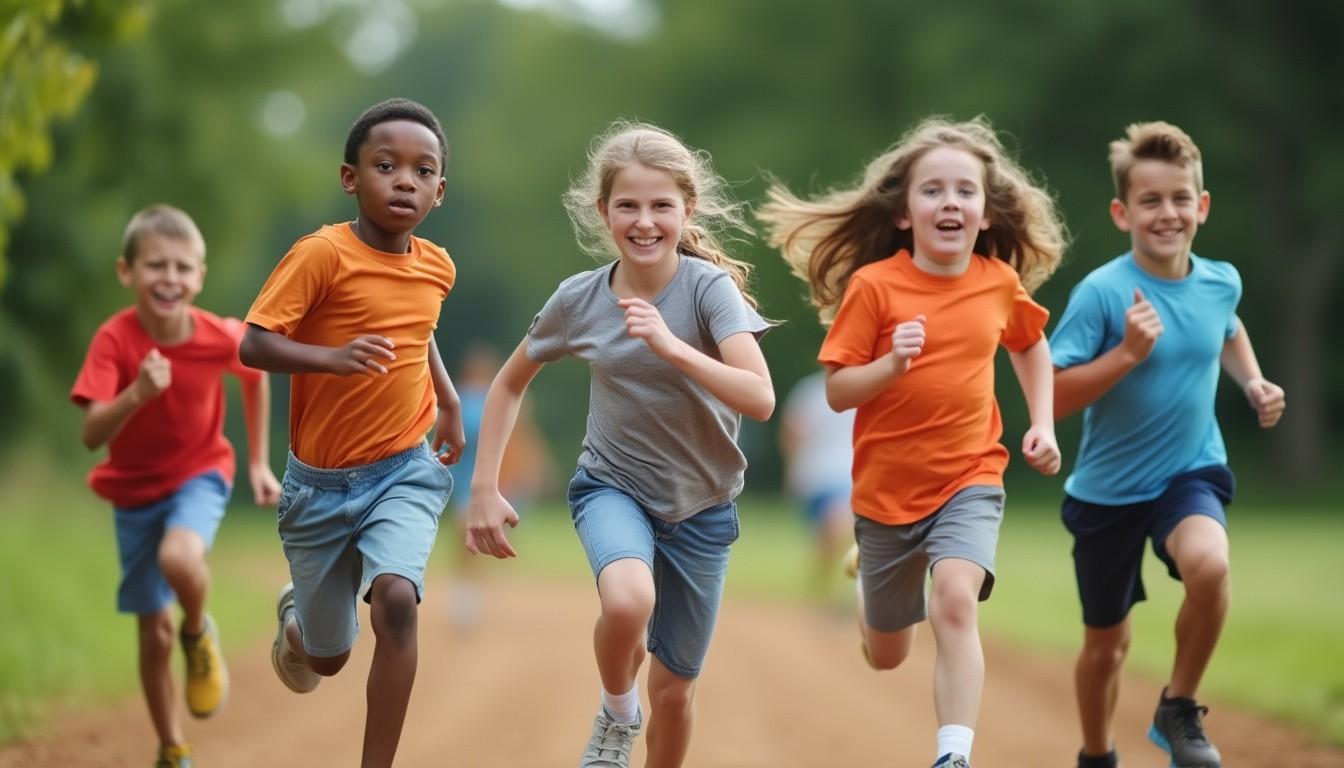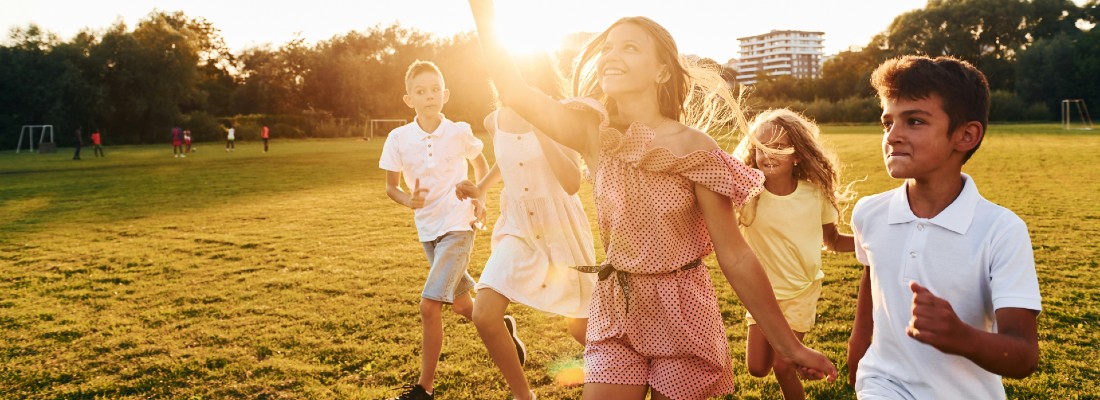Are you looking for a way to channel your kids’ boundless energy into something fun and productive? Look no further than relay races! These exciting group activities not only get children moving but also teach valuable lessons in teamwork, coordination, and quick thinking.
As a parent, you’ll love how relay races can transform any gathering into an unforgettable experience. Whether you’re planning a birthday party, a family reunion, or just a weekend playday, these versatile games are sure to keep young minds engaged and bodies active.
Plus, with a little creativity, you can easily adapt relay races to fit any theme or learning objective, making them perfect for supporting your child’s STEM and STEAM education at home.
Relay Race Ideas for Kids: Benefits of Participating
Relay races offer numerous advantages for children’s physical, social, and cognitive development. These engaging activities provide a fun and structured way for kids to exercise while learning important life skills.
Physical Development
Relay races, including the basic relay race with essential materials like batons and markers, improve gross motor skills through various movements:
- Running: Enhances cardiovascular endurance and leg strength
- Jumping: Boosts coordination and balance
- Throwing: Develops upper body strength and hand-eye coordination
- Crawling: Improves core strength and body awareness
Social Skills
Participating in relay races helps children develop essential social abilities:
- Teamwork: Kids learn to cooperate and work towards a common goal
- Communication: Encourages clear and effective communication among team members, emphasizing the crucial role each team member plays in completing the course
- Sportsmanship: Teaches children to handle winning and losing gracefully
- Leadership: Allows kids to take on leadership roles within their teams
Cognitive Benefits
Relay races stimulate mental growth and problem-solving skills:
- Strategic thinking: Kids learn to plan and execute strategies for winning
- Quick decision-making: Encourages rapid problem-solving under pressure
- Following instructions: Improves listening skills and ability to follow rules
- Adaptability: Teaches children to adjust to changing situations and obstacles
Emotional Development
These activities contribute to children’s emotional well-being:
- Confidence: Success in races boosts self-esteem and self-confidence
- Stress relief: Physical activity helps reduce stress and anxiety
- Emotional regulation: Kids learn to manage emotions in competitive situations
- Sense of accomplishment: Completing races provides a feeling of achievement
By incorporating relay races into children’s activities, you’re providing them with a fun and effective way to develop crucial life skills while staying active and engaged.

Setting Up Successful Relay Races
Organizing relay races for kids requires careful planning and preparation. Here’s how to set up exciting and safe relay races that children will love.
Forming Teams
Create balanced teams to ensure fair competition. Divide participants based on age, skill level, or randomly to promote inclusivity. Aim for 4-6 members per team, allowing each child to participate actively. Consider using colored bandanas or jerseys to distinguish teams easily. The goal is for the first team to complete the designated relay activity and reach the finish line.
Choosing the Right Location
Select a spacious, obstacle-free area for the relay races. Indoor spaces like gymnasiums or large rooms work well for inclement weather. Outdoor locations such as parks or playgrounds offer more space and natural elements. Ensure the chosen area has a smooth, level surface to prevent trips and falls.
Essential Equipment
Gather necessary supplies for your relay races:
- Batons or objects for passing (e.g., pool noodles, stuffed animals)
- Cones or markers to define the race course
- Stopwatch or timer for tracking race duration
- Whistle or horn for signaling starts and finishes
- First aid kit for minor injuries
- Water and snacks to keep participants hydrated and energized
Clearly marking the starting line is crucial to ensure all participants begin the race fairly and simultaneously.
Set up the race course using cones or markers, clearly indicating start and finish lines. Create lanes for each team to prevent collisions during the race. Double-check all equipment for safety before beginning the event.
Classic Relay Race Ideas
Classic relay races have stood the test of time, offering fun and excitement for kids of all ages. These timeless favorites challenge participants’ skills, coordination, and teamwork while providing endless entertainment. Traditional relay races are effective and enjoyable team-building activities that foster teamwork, communication, and collaboration.
Egg and Spoon Race
The Egg and Spoon Race tests balance and concentration. Participants balance an egg on a spoon while racing from one point to another. If the egg falls, the contestant must return to the starting point. For larger groups, form relay teams to increase the challenge and excitement. Team members take turns balancing the egg and spoon, passing it to the next team member to maintain the flow of the race.
Three-Legged Race
The Three-Legged Race promotes teamwork and coordination. Partners have their inside legs tied together, creating a three-legged team. Teams race to the finish line, requiring synchronization and communication. For added difficulty, set up an obstacle course for the three-legged pairs to navigate.
Sack Race
The Sack Race combines hopping skills with balance. Participants step into burlap sacks and hop to the finish line. This race encourages core strength and agility while providing plenty of laughs. For a relay version, have team members take turns hopping a set distance before passing the sack to the next player.
Wheelbarrow Race
The Wheelbarrow Race builds upper body strength and trust between partners. One partner holds the legs of the other, who walks on their hands. Teams race to the finish line, switching positions halfway through. This race improves coordination and teamwork while offering a unique physical challenge.
Creative Relay Race Variations
These innovative relay race ideas add excitement and challenge to traditional races. Each variation incorporates unique elements that test different skills and keep kids engaged. Fun relay race ideas are adaptable and engaging for various settings, such as birthday parties, gym classes, and team-building events, encouraging teamwork and communication among participants.
Dress-Up Relay
Transform a simple race into a fun relay race that doubles as a hilarious costume party with a dress-up relay. Place a box of oversized clothes and accessories at the turnaround point. Racers must put on all items, run back to their team, remove the clothes, and pass them to the next player. This relay enhances dexterity, speed, and creates loads of laughter.
Hula-Hoop Pass
The hula-hoop pass relay combines teamwork with physical coordination. Teams form a line and pass a hula-hoop from one end to the other without breaking hand contact. Players step through the hoop to pass it along. This relay improves flexibility, problem-solving, and group dynamics.
Water Balloon Challenge
Add a splash of excitement with a water balloon relay. Teams race to fill a bucket at the finish line using water balloons. Players must carefully carry or toss water-filled balloons without breaking them. This relay tests hand-eye coordination, gentle handling, and adds a refreshing element to hot summer days.
Obstacle Course Relay
Create an exciting obstacle course relay to challenge multiple skills. Set up stations with tasks like crawling under nets, jumping over hurdles, or navigating a balance beam. This relay enhances agility, balance, and problem-solving as kids tackle various obstacles. Customize the course difficulty based on age groups for an inclusive experience.
Skill-Building Relay Races
Skill-building relay races combine fun with targeted learning, helping kids develop specific abilities while enjoying friendly competition. These races focus on enhancing particular skills, from balance and coordination to teamwork and academic knowledge.
Relay race games promote cooperation and communication among participants, making them excellent team-building activities that encourage shared challenges and teamwork.
Balancing Act Races
Balancing act races challenge kids to maintain equilibrium while completing tasks. In the “Egg and Spoon Shuffle,” participants balance an egg on a spoon while navigating a set course. The “Beach Ball Balance” race requires teams to transport a beach ball using only their heads or backs. These activities improve core strength, body awareness, and concentration.
Teamwork-Focused Relays
Teamwork-focused relays encourage cooperation and communication among participants. The “Human Chain” race involves team members linking arms to form a chain, then navigating an obstacle course together. In the “Balloon Pop Relay,” teams work collectively to pop balloons using body parts other than hands. These races foster trust, coordination, and collaborative problem-solving skills.
Educational Relay Games
Educational relay games blend physical activity with academic learning. The “Math Sprint” involves solving simple equations before running to the next checkpoint. In the “Spelling Bee Relay,” participants spell out words using letter cards they collect along the course. The “Geography Dash” requires teams to match country names with their capitals or flags. These games reinforce classroom concepts while keeping kids active and engaged.
Indoor Relay Race Ideas
Balloon Pop Relay
The Balloon Pop Relay combines speed, coordination, and excitement. Teams race to pop balloons using creative methods like sitting on them or stomping them. This high-energy game keeps kids engaged and laughing throughout the event.
Costume Change Relay
Transform your indoor space into a dress-up extravaganza with the Costume Change Relay. Participants sprint to a designated area, quickly don silly outfits, and race back to tag their teammates. This game enhances dexterity and provides endless amusement.
Book Balance Relay
Promote reading while improving balance with the Book Balance Relay. Kids carefully balance books on their heads as they navigate a set course. This game develops posture, concentration, and an appreciation for literature.
Ping Pong Ball and Spoon Race
A twist on the classic egg and spoon race, this indoor version uses ping pong balls. Participants balance the lightweight balls on spoons while maneuvering through an obstacle course. It’s a test of steady hands and focused movement.
Newspaper Dance Relay
Combine music and agility in the Newspaper Dance Relay. Teams dance on newspaper sheets, folding them smaller after each round. The last team with members still on their paper wins. This game encourages creativity and spatial awareness.
Straw and Paper Relay
In this breath-control challenge, kids use straws to blow small paper balls across the floor to their teammates. It’s a unique way to develop lung capacity and precision while having fun indoors.
Puzzle Piece Relay
Enhance problem-solving skills with the Puzzle Piece Relay. Teams race to collect puzzle pieces and assemble them correctly. This game promotes teamwork and strategic thinking in a fast-paced environment.
Memory Relay
Test recall abilities in the Memory Relay. Participants view a tray of objects briefly, then race to write down or collect matching items. This game sharpens observation skills and short-term memory.
Cup Stacking Relay
Stack and unstack cups in record time with the Cup Stacking Relay. Teams compete to create specific cup formations quickly and accurately. This game improves hand-eye coordination and fine motor skills.
Scavenger Hunt Relay
Turn your indoor space into an adventure zone with a Scavenger Hunt Relay. Teams race to find specific items listed on their cards. This game combines physical activity with problem-solving and observation skills.
Outdoor Relay Race Ideas
Classic Outdoor Relay Races
Outdoor spaces offer endless possibilities for exciting relay races. These classic outdoor relay races have stood the test of time:
- Baton Relay: Teams pass a baton while running laps around a designated course.
- Sack Race Relay: Participants hop in sacks to the finish line, then pass the sack to their teammates.
- Water Bucket Relay: Teams transfer water from one bucket to another using cups or sponges.
- Egg and Spoon Race: Runners balance an egg on a spoon while racing to the finish line.
Nature-Inspired Relay Races
Incorporate natural elements into your outdoor relay races:
- Leaf Collecting Relay: Teams gather specific types of leaves from designated areas.
- Rock Stacking Challenge: Participants race to create the tallest rock stack within a time limit.
- Pinecone Toss: Teams toss pinecones into buckets at varying distances.
- Acorn Hunt: Runners search for hidden acorns and bring them back to their team’s basket.
Sports-Themed Relay Races
Combine popular sports with relay race elements:
- Soccer Dribble Relay: Players dribble a soccer ball through an obstacle course.
- Basketball Bounce Relay: Participants bounce a basketball while running to the finish line.
- Frisbee Toss Relay: Teams toss a frisbee to each other while advancing down the field.
- Hula Hoop Roll: Runners roll a hula hoop to the finish line and back.
Obstacle Course Relay Races
Create challenging obstacle courses for added excitement:
- Tire Run: Participants run through a series of tires placed on the ground.
- Rope Climb: Teams climb a rope or cargo net as part of the relay.
- Balance Beam Walk: Runners navigate a balance beam while carrying an object.
- Hurdle Jump: Participants jump over low hurdles placed along the race course.
- Sponge Relay: Teams transfer water using sponges to fill a bucket at the finish line.
- Water Balloon Toss: Pairs toss water balloons back and forth, increasing distance each round.
- Slip ‘n Slide Relay: Runners slide down a wet plastic sheet to reach the finish line.
- Cup on Head Race: Participants balance a cup of water on their heads while racing.
Adapting Relay Races for Different Age Groups
Preschoolers (Ages 3-5)
Relay races for preschoolers focus on simple, fun movements. Keep the rules straightforward and the courses short. Use large, colorful objects that are easy to handle. Examples include:
- Bean Bag Toss Relay: Kids throw soft bean bags into a bucket
- Animal Walk Relay: Children imitate animal movements like frog jumps or bear crawls
- Ball Roll Relay: Participants push a large ball with their hands to a finish line
Elementary School Kids (Ages 6-11)
Elementary-aged children can handle more complex rules and longer courses. Incorporate skill-building elements and teamwork. Try these ideas:
- Egg and Spoon Race: Balance an egg (or ping pong ball) on a spoon while racing
- Sack Race: Hop in burlap sacks to the finish line
- Three-Legged Race: Partners tie their inside legs together and run as a team
In relay races, teams line up and organize participants in a sequence, ensuring each member completes their task while maintaining coordination and teamwork.
Tweens and Teens (Ages 12-17)
Older kids enjoy challenges that test their strength, speed, and strategy. Add competitive elements and obstacles. Consider these options:
- Obstacle Course Relay: Include hurdles, crawling segments, and balance beams
- Water Bucket Relay: Teams transfer water using cups to fill a bucket
- Blindfolded Puzzle Relay: Teammates guide a blindfolded player to complete a puzzle
- Role-Based Relay: Assign different tasks based on age (e.g., younger kids carry lightweight items, older kids navigate obstacles)
- Partner Relay: Pair older and younger participants for activities like piggyback races
- Staggered Start Relay: Give younger players a head start to level the playing field
The goal in each relay event is to cross the finish line first and become the winning team.
Safety Tips for Relay Races
When organizing relay races for kids, safety should be your top priority. Follow these essential safety tips to ensure a fun and injury-free experience:
Clear the Course
Before starting any relay race:
- Remove obstacles from the race path
- Check for uneven surfaces or potential tripping hazards
- Ensure adequate lighting for indoor races
- Mark the course clearly with cones or tape
Proper Equipment
Use age-appropriate and safe equipment:
- Choose soft, lightweight batons for passing
- Opt for plastic or foam alternatives to traditional items (e.g., plastic eggs instead of real ones)
- Ensure all equipment is in good condition and free from sharp edges
Supervision
Maintain constant adult supervision:
- Station adults at key points along the course
- Have a designated safety monitor to watch for potential hazards
- Ensure a proper adult-to-child ratio based on the age group
Warm-up and Stretching
Prepare participants’ bodies for physical activity:
- Lead a 5-minute warm-up session before races
- Demonstrate and guide proper stretching techniques
- Focus on major muscle groups used in running and other relay activities
Hydration Stations
Keep participants hydrated:
- Set up water stations along the course
- Encourage regular water breaks between races
- Provide easily accessible drinking water for all participants
Weather Considerations
Adapt to weather conditions:
- Check the forecast before outdoor events
- Have a backup indoor location for inclement weather
- Provide sunscreen and shade for hot, sunny days
- Ensure proper clothing for colder temperatures
First Aid Preparedness
Be ready for minor injuries:
- Keep a well-stocked first aid kit on hand
- Have a designated first aid provider present
- Know the location of the nearest medical facility
Clear Instructions
Provide clear rules and guidelines:
- Explain race rules thoroughly before starting
- Demonstrate proper techniques for specific relay tasks
- Emphasize the importance of fair play and good sportsmanship
By implementing these safety measures, you’ll create a secure environment for kids to enjoy relay races while minimizing the risk of accidents or injuries.
Conclusion
Relay races offer an exciting way to engage kids in physical activity while developing crucial skills. By incorporating these fun and versatile games into your children’s routines you’ll promote teamwork coordination and quick thinking. Whether you choose classic races or creative variations there’s a relay race for every occasion and age group. Remember to prioritize safety and adapt the games as needed. With these relay race ideas you’ll create memorable experiences that keep kids active entertained and learning. So gather your supplies set up your course and let the races begin!







0 Comments